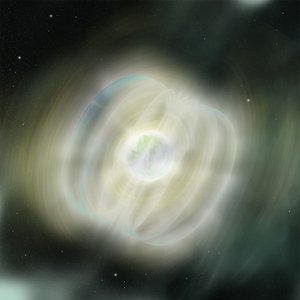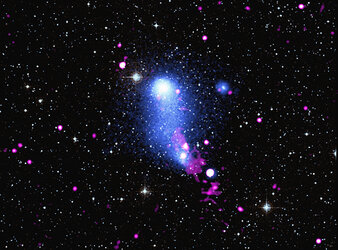Explosion reveals tiny magnetic island
ESA’s XMM-Newton, has provided new insight into puzzling celestial objects known as magnetars. Thanks to the orbiting X-ray observatory, astronomers have traced powerful explosions to a region just beneath a magnetar’s surface.
Magnetars are small neutron stars that occasionally suffer extraordinarily powerful outbursts which shine X-rays across the galaxy.
In 2003, astronomers saw a neutron star brighten to around 100 times its usual faint luminosity. This outburst allowed them to discover XTE J1810-197. Detecting pulsations from the source helped classify it as the first transient anomalous X-ray pulsar (AXP). The massive outburst moved it to the rank of magnetar.
Magnetars are perplexing objects. Each one is the highly magnetic core of a star that was once at least eight times more massive than the Sun. When it exploded as a supernova, the core was compressed into a highly compact object, a neutron star, roughly fifteen kilometres in diameter, but containing about as much mass as the Sun.
Some of these neutron stars possess the most powerful magnetic fields in the Universe, leading to extremely energetic eruptions that send high-energy radiation cascading across space. Astronomers have never been certain whether the outbursts come from the surface of the magnetar itself, or the clouds of electrically charged particles trapped in the surrounding magnetic field.

Now, using data from XMM-Newton, Tolga Güver, Istanbul University, and his colleagues have analysed the X-ray spectrum of XTE J1810-197 using a computer model that incorporates emission from the magnetar’s surface with its subsequent processing as it travels through the object’s magnetic field. This is the first time both regions of a magnetar have been put together in the same computer model.
XMM-Newton observed XTE J1810-197 seven times between 9 August 2003 and 12 March 2006 using XMM's European Photon Imaging Camera (EPIC) on board XMM. During that time, the object faded back to normal brightness, and EPIC recorded the changes in the energies of the X-rays released as it did so. These changes are particularly valuable to astronomers because they can be compared with computer predictions.
Güver and colleagues found that the data were best fitted with a model that traced the outburst to just below the surface of the magnetar and confined it to an area about 3.5 km across. This is a breakthrough because, “Assuming our model is confirmed, we can now distinguish between surface and magnetopheric phenomena,” says Güver.
Their model also allowed them to determine the strength of this object’s magnetic field spectroscopically. It is around six hundred million, million times stronger than Earth’s magnetic field. Encouragingly, this measurement is similar to an estimate made previously for this object based on how fast its spin is slowing down. This boosts the team’s confidence that their model is correct.
Nevertheless, they are not being complacent about their work. “This model will not be the final one about magnetars but it does give us a new point of view onto these fascinating objects,” says Güver.
One thing that remains unclear is the nature of the outburst. It is probably triggered magnetically but exactly how, is still a mystery. The team now plan to use their computer model to investigate more of these celestial objects, using more data from XMM-Newton, in their quest for answers.
Notes for editors:
‘The Magnetar Nature and the Outburst Mechanism of a Transient Anomalous X-ray Pulsar’ by T. Güver, F. Özel, E. Göğüş and C. Kouveliotou is due to be published in The Astrophysical Journal, on 20 September 2007.
For more information:
Tolga Güver, Istanbul University
Email: Tolga @ istanbul.edu.tr
Norbert Schartel, ESA XMM-Newton Project Scientist
Email: Norbert Schartel @ esa.int















 Germany
Germany
 Austria
Austria
 Belgium
Belgium
 Denmark
Denmark
 Spain
Spain
 Estonia
Estonia
 Finland
Finland
 France
France
 Greece
Greece
 Hungary
Hungary
 Ireland
Ireland
 Italy
Italy
 Luxembourg
Luxembourg
 Norway
Norway
 The Netherlands
The Netherlands
 Poland
Poland
 Portugal
Portugal
 Czechia
Czechia
 Romania
Romania
 United Kingdom
United Kingdom
 Slovenia
Slovenia
 Sweden
Sweden
 Switzerland
Switzerland






































